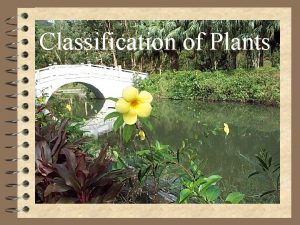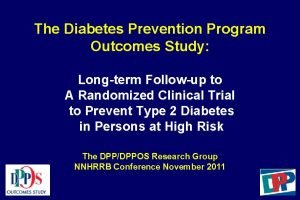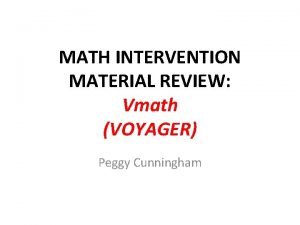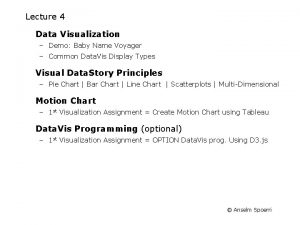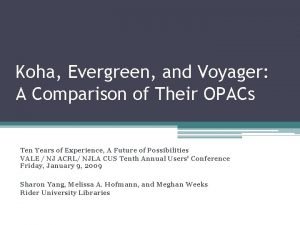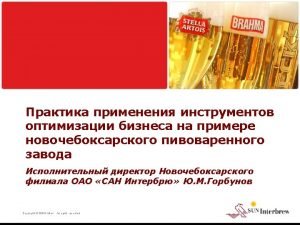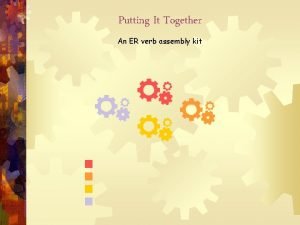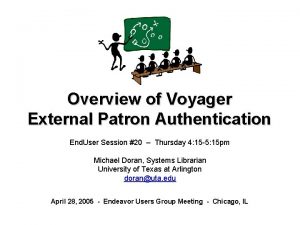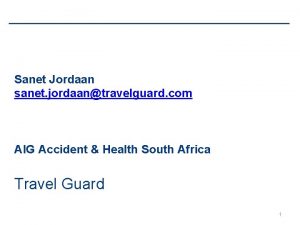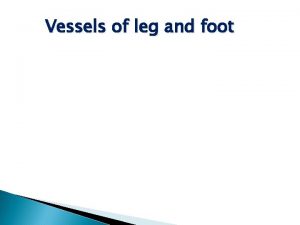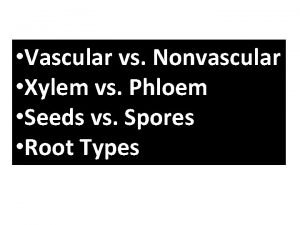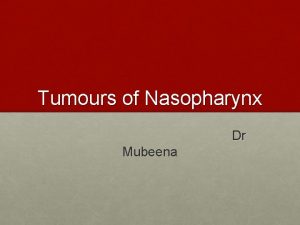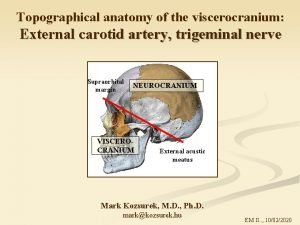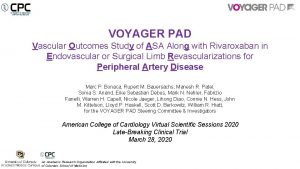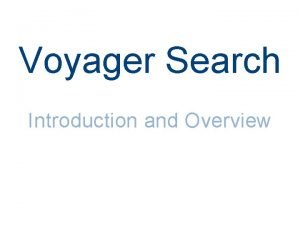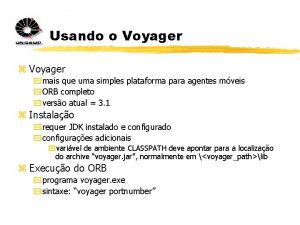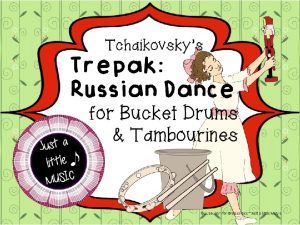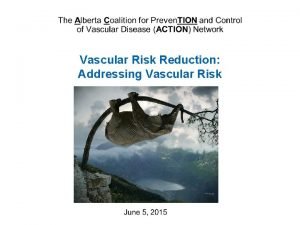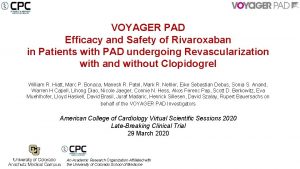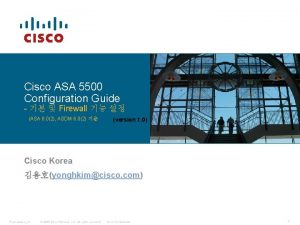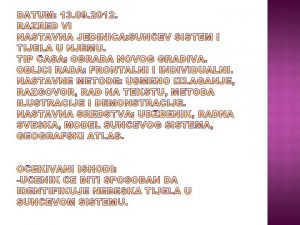VOYAGER PAD Vascular Outcomes Study of ASA Along


























- Slides: 26

VOYAGER PAD Vascular Outcomes Study of ASA Along with Rivaroxaban in Endovascular or Surgical Limb Revascularizations for Peripheral Artery Disease Marc P. Bonaca, Rupert M. Bauersachs, Manesh R. Patel, Sonia S. Anand, Eike Sebastian Debus, Mark N. Nehler, Fabrizio Fanelli, Warren H. Capell, Nicole Jaeger, Lihong Diao, Connie N. Hess, John M. Kittelson, Lloyd P. Haskell, Scott D. Berkowitz, William R. Hiatt, for the VOYAGER PAD Steering Committee & Investigators American College of Cardiology Virtual Scientific Sessions 2020 Late-Breaking Clinical Trial March 28, 2020 An Academic Research Organization Affiliated with the University of Colorado School of Medicine

Disclosures VOYAGER PAD was funded by Bayer & Janssen Grant support to CPC Clinical Research from: Amgen, Aralez, Astra. Zeneca, Bayer, Janssen, Merck, Novo Nordisk, Pfizer, Sanofi 2

Background Risk in Patients Undergoing Peripheral Revascularization Outcomes in Patients with Acute Limb Ischemia N=393, 017 Cumulative Incidence “Acute” Post Revascularization • Median hospitalization 8 days (IQR 5 -15) “Stable” Phase Major Adverse Limb Events 4 x risk of ALI Long-term vs. no Revascularization MACE Years from Index Revascularization • ~4% die at presentation • ~1/5 major amputation • ~1/3 prolonged ICU stay • ~3/4 major surgery • Outcomes after hospitalization are poor with ~15% disabled or dead Hess…Hiatt et al. JACC 2020 Jones…Fowkes et al. Circulation 2017 Bonaca…Sabatine et al. JACC 2017 Bonaca…Morrow et al. Circulation 2016 3

Background Despite the high risk, currently there is no proven antithrombotic strategy that has demonstrated efficacy for reducing major adverse limb and cardiovascular events after peripheral intervention for ischemia Index-graft occlusion, revascularization, major amputation, or death HR 0. 98 (95% CI 0. 78 – 1. 23), P=NS DAPT with Aspirin and Clopidogrel Increased GUSTO bleeding HR 2. 84 (1. 32 – 6. 08) Graft Occlusions HR 0. 95 (95% CI 0. 82 – 1. 11), P=NS Full Intensity Oral anticoagulation Increased risk of Hemorrhagic Stroke HR 3. 48 (1. 14 – 10. 60) Belch et al. Journal of Vascular Surgery. 2010 Dutch Bypass Oral anticoagulants or Aspirin (BOA) Study Group. Lancet. 2000 4

Objectives In PAD patients undergoing lower extremity revascularization for ischemic symptoms: • Test whether rivaroxaban 2. 5 mg twice daily added to low dose aspirin reduces the risk of major adverse limb and cardiovascular events compared to aspirin alone • To evaluate the safety of rivaroxaban 2. 5 mg twice daily added to low dose aspirin compared to aspirin alone 5

Trial Design NCT 02504216 6, 564 Patients with Symptomatic Lower Extremity PAD* Undergoing Peripheral Revascularization *Ankle Brachial Index < 0. 90 and Imaging Evidence of Occlusive Disease ASA 100 daily for all Patients Clopidogrel at Investigator’s Discretion Randomized 1: 1 Double Blind Rivaroxaban 2. 5 mg twice daily Stratified by Revascularization Approach (Surgical or Endovascular) and Use of Clopidogrel Placebo Follow up Q 6 Months, Event Driven, Median f/u 28 Months Primary Efficacy Endpoint: Acute limb ischemia, major amputation of vascular etiology, myocardial infarction, ischemic stroke or cardiovascular death Principal Safety Outcome: TIMI Major Bleeding Capell WH, Bonaca MP, Nehler MR…Hiatt WR. AHJ 2018 6

Inclusion & Exclusion Inclusion Exclusion • Age ≥ 50 • Revascularization for asymptomatic disease • Documented PAD including: • Recent revascularization (within 10 days) or ALI (2 weeks) or ACS (30 days) • Current major tissue loss • Need for antiplatelet or anticoagulant other than aspirin and/or clopidogrel • Need for long-term DAPT (intended > 6 months) • High risk for bleeding (significant bleeding in last 6 months, prior stroke or other high-risk condition) 7 • • Ischemic symptoms (functional limitation, rest pain or ischemic ulceration) AND • Imaging evidence of occlusion AND • Abnormal ABI Successful lower extremity revascularization for ischemia

Outcomes Efficacy Primary: acute limb ischemia (ALI), major amputation for vascular cause (amputation), myocardial infarction (MI), ischemic stroke or CV death Secondary (hierarchical): 1. ALI, amputation, MI, ischemic stroke or coronary heart death 2. Unplanned index limb revascularization for ischemia 3. Vascular hospitalization for a coronary or peripheral event of thrombotic nature 4. ALI, amputation, MI, ischemic stroke or all-cause mortality 5. ALI, amputation, MI, all stroke or CV death 6. All-cause mortality 7. Venous thromboembolism Safety Principal: TIMI major bleeding Secondary: ISTH major bleeding, BARC 3 b or above CPC Clinical Events Committee (CEC) adjudicated all efficacy and safety events 8

Trial Organization Executive Committee William R. Hiatt (Chair) Marc P. Bonaca Eike Sebastian Debus Lloyd P. Haskell Rupert M. Bauersachs (Co-Chair) Sonia S. Anand Mark R. Nehler Scott D. Berkowitz Manesh R. Patel Fabrizio Fanelli CPC Clinical Research Warren H. Capell (ICAC Chair), Jennifer Armstrong (ICAC Member), Natalia Glebova, (ICAC Member), Connie N. Hess (ICAC Member), Mori Krantz (ICAC Member), Cecilia Low-Wang (ICAC Member), Lisa Cox (Executive Project Manager), Nicole Jaeger (Project Manager), Robin White (Director, Biostatistics and Programming), and Lihong Diao (Biostatistician). Sponsors: Bayer & Janssen Scott D. Berkowitz, Lloyd Haskell, Eva Muehlhofer, James Hung, Aneta Woroniecka-Osio MD, Uma Balasubramanian, Juliette Dehay, Alexandra Kley, Claudia Vogt, Akos Ferenc Pap Independent Data Monitoring Committee John Dormandy (Chair)*, Joshua Beckman (Chair), Scott Kinlay, Robert Mc. Lafferty, Robin Roberts, (Statistician), and William Robinson. *Deceased 9

Steering Committee and National Lead Investigators Argentina R. Diaz Austria M. Brodmann Belgium F. Vermassen Brazil D. Brasil Bulgaria V. Chervenkoff Canada D. Szalay Czech Republic K. Roztocil China W. Fu / Z. Shi Denmark H. Sillesen Estonia P. Põder Finland M. Venermo France A. Bura-Rivière J. Baptiste Ricco Germany D. Scheinert (Co-Chair) H. Lawall Hungary L. Matyas Italy C. Rabbia M. Antonella Ruffino F. Violi Japan H. Shigematsu Y. Soga Y. Yonemitsu Latvia/Lithuania D. Krievins Netherlands F. Moll Poland A. Jawien Portugal A. Mansilha Romania I. Coman Russia A. Svetlikov Serbia I. Koncar Slovokia J. Maďarič South Korea D. Choi Spain V. Riambau Alonso Sweden L. Norgren Switzerland I. Baumgartner Taiwan S. Shen Wang Thailand P. Mutirangura Ukraine I. Gudz United Kingdom G. Hamilton United States A. Hirsch (Co-Chair)* R. Powell (Co-Chair) J. Chung J. Kittelson (Biostatistician) J. Mills J. Mustapha F. Saab *Deceased 10

Global Enrollment 6, 564 patients randomized at 534 sites in 34 countries between 7/2015 – 1/2018 Finland: 17 Czech Republic: 243 Denmark: 78 Sweden: 42 Germany: 594 Belgium: 126 Netherlands: 78 Poland: 168 Estonia: 9 Latvia: 203 Hungary: 261 Ukraine: 299 Slovakia: 126 Lithuania: 84 Bulgaria: 737 Romania: 214 Canada: 170 United States: 524 Russia: 188 United Kingdom: 129 Austria: 212 France: 107 Portugal: 75 South Korea: 148 Japan: 459 China: 211 Spain: 96 Switzerland: 91 Italy: 184 Taiwan: 76 Serbia: 68 Thailand: 67 Brazil: 185 Argentina: 299 11

Disposition 6, 772 Patients Enrolled 6, 564 Patients Randomized Placebo N=3278 Rivaroxaban N=3286 Premature Drug Discontinuation = 1011 (31. 1%) 13. 2% Annualized Premature Drug Discontinuation = 1080 (33. 2%) 14. 2% Annualized Withdrawal of Consent = 32 (0. 97%) 0. 42% Annualized Vital status unknown = 8 (0. 24%) Not Randomized = 208 Inclusion/Exclusion 167 Subject decision 29 Adverse event 2 Physician decision 1 Other 9 Median Follow-up 28 Months Withdrawal of Consent = 37 (1. 13%) 0. 48% Annualized Vital status unknown = 12 (0. 37%) Lost to Follow up = 3 (0. 09%) Vital Status Known = 3275 (99. 7%) Vital Status Known = 3263 (99. 5%) Analyzed ITT = 3286 (100%) Safety = 3256 (99. 1%) Analyzed ITT = 3278 (100%) Safety = 3248 (99. 1%) Complete primary efficacy and principal safety outcome ascertainment in 98. 8% of potential patient-years of follow up 12

Baseline Characteristics at Randomization Rivaroxaban 2. 5 mg twice daily + aspirin N=3286 % Placebo + aspirin Age, Yrs Median 67 67 Female 26 26 Caucasian 81 81 Diabetes Mellitus 40 40 Current Smoking 35 35 COPD 11 11 e. GFR < 60 ml/min/1. 73 m 2 20 20 Coronary Artery Disease 32 31 Prior MI 11 11 Known Carotid Stenosis 9 9 Clopidogrel 51 51 Statin 79 81 ACEi or ARB 64 63 N=3278 % P>0. 05 for all comparisons 13

PAD & Procedural Characteristics at Randomization Rivaroxaban 2. 5 mg twice daily + aspirin N=3286 % Placebo + aspirin History of Claudication 95 96 History of Revascularization 36 35 History of Amputation 6 6 0. 56 (0. 42 – 0. 67) Critical limb ischemia 23 24 Claudication 77 76 Surgical 35 35 Endovascular or Hybrid 66 65 5 (2 – 7) N=3278 % Prior Peripheral Artery Disease History Ankle Brachial Index, Median (IQR) Indication for Revascularization Type of Revascularization Days from Procedure to Randomization, Median (IQR) P>0. 05 for all comparisons 14

Primary Endpoint Acute limb ischemia, major amputation for vascular cause, myocardial infarction, ischemic stroke, CV death 20 20 Cumulative Incidence (KM%) 18 18 19. 9% Placebo Rivaroxaban 17. 3% 16 16 14 14 12 12 10 10 HR 0. 85 95% CI 0. 76 – 0. 96 P=0. 0085 88 66 44 22 00 ########0 ########0 ########0 ########0 ########0 ########0 3 6 9 12 15 18 21 24 27 30 33 Months from Randomization 15 36

Primary Endpoint Acute limb ischemia, major amputation for vascular cause, myocardial infarction, ischemic stroke, CV death 19. 9% Placebo 20 20 Rivaroxaban 18 18 Cumulative Incidence (KM%) 3 Year ARR 2. 6% NNT 39 17. 3% 16 16 14 14 1 Year ARR 2. 0% NNT 50 12 12 6 Months ARR 1. 5% NNT 65 10 10 88 HR 0. 85 95% CI 0. 76 – 0. 96 P=0. 0085 66 44 22 00 ########0 ########0 ########0 ########0 ########0 ########0 3 6 9 12 15 18 21 24 27 30 33 Months from Randomization ARR – absolute risk reduction, NNT number needed to treat 16 36

Primary Endpoint & Components KM% 3 Years (n) Rivaroxaban N=3286 KM% 3 Years (n) Placebo N=3278 HR (95% CI) Primary Efficacy Outcome 17. 3 19. 9 0. 85 (0. 76 – 0. 96) Acute Limb Ischemia 5. 24 7. 74 0. 67 (0. 55 – 0. 82) Major Vascular Amputation 3. 42 3. 87 0. 89 (0. 68 – 1. 16) Ischemic Stroke 2. 70 3. 01 0. 87 (0. 63 – 1. 19) Myocardial Infarction 4. 55 5. 22 0. 88 (0. 70 – 1. 12) CV Death 7. 05 6. 43 1. 14 (0. 93 – 1. 40) 17

Secondary Outcomes* Placebo Cumulative Incidence (KM%) at 3 years Rivaroxaban HR 0. 80 (0. 71 – 0. 91) P=0. 0008 ARR 3. 52 25% HR 0. 88 (0. 79 – 0. 99) P=0. 028 ARR 2. 48 HR 0. 72 (0. 62 – 0. 85) P=0. 0001 ARR 3. 38 HR 0. 89 (0. 79 – 0. 99) P=0. 0289 ARR 2. 59 23. 2% 22. 5% 15% 20. 6% 20. 0% 20% HR 0. 86 (0. 76 – 0. 96) P=0. 0103 ARR 2. 63 20. 1% 18. 2% 17. 5% HR 1. 08 (0. 92 – 1. 27) P=0. 3360 HR 0. 61 (0. 37 – 1. 00) P=0. 0469 14. 7% 12. 1% 10% 11. 1% 10. 9% 8. 7% 5% 0. 8% 0% 433 528 584 655 262 356 614 679 MI, Ischemic Stroke, Unplanned Limb Vascular Hosp. for a MI, Ischemic Stroke, CHD, ALI, Amp Revacularization for Coronary or ALI, Amp, All Cause Ischemia Peripheral Mortality Thrombotic Event 514 588 MI, All Stroke, CV Death, ALI, Amp *Presented in order of hierarchy from left to right 321 297 Mortality 25 1. 7% 41 VTE Nominal, due to position in hierarchy 18

Secondary Outcomes* Placebo Cumulative Incidence (KM%) at 3 years Rivaroxaban HR 0. 80 (0. 71 – 0. 91) P=0. 0008 ARR 3. 52 25% HR 0. 88 (0. 79 – 0. 99) P=0. 028 ARR 2. 48 HR 0. 72 (0. 62 – 0. 85) P=0. 0001 ARR 3. 38 HR 0. 89 (0. 79 – 0. 99) P=0. 0289 ARR 2. 59 23. 2% 22. 5% 15% 20. 6% 20. 0% 20% HR 0. 86 (0. 76 – 0. 96) P=0. 0103 ARR 2. 63 20. 1% 18. 2% 17. 5% HR 1. 08 (0. 92 – 1. 27) P=0. 3360 HR 0. 61 (0. 37 – 1. 00) P=0. 0469 14. 7% 12. 1% 10% 11. 1% 10. 9% 8. 7% 5% 0. 8% 0% 433 528 584 655 262 356 614 679 MI, Ischemic Stroke, Unplanned Limb Vascular Hosp. for a MI, Ischemic Stroke, CHD, ALI, Amp Revacularization for Coronary or ALI, Amp, All Cause Ischemia Peripheral Mortality Thrombotic Event 514 588 MI, All Stroke, CV Death, ALI, Amp *Presented in order of hierarchy from left to right 321 297 Mortality 25 1. 7% 41 VTE Nominal, due to position in hierarchy 19

Primary Efficacy Outcome in Selected Subgroups Rivaroxaban Better 0. 75 1. 0 1. 50 Placebo Better 20

Placebo Safety Rivaroxaban Cumulative Incidence (KM%) at 3 years 9% HR 1. 43 (0. 97 – 2. 10) P=0. 0695 8% 7% HR 0. 78 (0. 38 – 1. 61) P=0. 50 HR 1. 02 (0. 33 – 3. 15) P=0. 98 HR 0. 91 (0. 47 – 1. 76) P=0. 79 HR 1. 50 (0. 95 – 2. 37) P=0. 078 HR 1. 29 (0. 95 – 1. 76) P=0. 098 HR 1. 42 (1. 10 – 1. 84) P=0. 0068 ARI 1. 8% ARI 0. 60% / year ARI 0. 8% NNH 125 ARI 0. 27% / year 5. 9% 6% 5% 4. 1% 3. 9% 4% 2. 9% 3% 2. 7% 1% 0% 1. 9% 2% 0. 6% 62 44 TIMI major 13 0. 9% 17 ICH 0. 7% 0. 2% 6 6 Fatal Principal Safety Outcome ARI – absolute risk increase, NNH number needed to harm 17 1. 2% 1. 0% 19 ICH or Fatal 46 31 TIMI minor 93 73 140 BARC 3 b or Greater 100 ISTH major Secondary Safety Outcomes 21

Placebo Safety Rivaroxaban Cumulative Incidence (KM%) at 3 years 9% HR 1. 43 (0. 97 – 2. 10) P=0. 0695 8% 7% HR 0. 78 (0. 38 – 1. 61) P=0. 50 HR 1. 02 (0. 33 – 3. 15) P=0. 98 HR 0. 91 (0. 47 – 1. 76) P=0. 79 HR 1. 50 (0. 95 – 2. 37) P=0. 078 HR 1. 29 (0. 95 – 1. 76) P=0. 098 HR 1. 42 (1. 10 – 1. 84) P=0. 0068 ARI 1. 8% ARI 0. 60% / year ARI 0. 8% NNH 125 ARI 0. 27% / year 5. 9% 6% 5% 4. 1% 3. 9% 4% 2. 9% 3% 2. 7% 1% 0% 1. 9% 2% 0. 6% 62 44 TIMI major 13 0. 9% 17 ICH 0. 7% 0. 2% 6 6 Fatal Principal Safety Outcome ARI – absolute risk increase, NNH number needed to harm 17 1. 2% 1. 0% 19 ICH or Fatal 46 31 TIMI minor 93 73 140 BARC 3 b or Greater 100 ISTH major Secondary Safety Outcomes 22

Principal Safety Outcome in Selected Subgroups 0. 75 1. 0 1. 50 23

First Events Prevented / Caused for 10, 000 Patients Treated* for 1 Year Primary Efficacy Outcome -181 (-269 – -94) -110 Acute Limb Ischemia (-165 – -56) -20 Major Amputation of Vascular Etiology -42 Myocardial Infarction (-84 – -1) -19 Ischemic Stroke (-50 – 13) -10 Cardiovascular Death (-48 – 28) 29 Principal Safety Outcome (-2 – 60) -6 Intracranial Hemorrhage (-22 – 11) 0 Fatal Bleeding -300 *Efficacy and safety on-treatment (-53 – 12) -200 -100 Favors Rivaroxaban 2. 5 mg twice daily plus aspirin 0 (-10 – 11) 100 200 Favors aspirin monotherapy 300 24

Summary & Conclusion • In symptomatic PAD after revascularization, ~1 in 5 have acute limb ischemia, major amputation of vascular etiology, MI, ischemic stroke or cardiovascular death at 3 years • In this population and setting, rivaroxaban 2. 5 mg twice daily with aspirin compared to aspirin alone: ü Significantly reduces this risk with… • Benefits apparent early and continued over time • Consistent benefit across major subgroups • Broad benefits including reductions in unplanned index limb revascularization ü Increases bleeding: in VOYAGER PAD, there was a numerical increase in TIMI major bleeding and significantly increased ISTH major bleeding but no excess in intracranial or fatal bleeding ü Prevents ~6 times as many ischemic events relative to bleeds caused in PAD patients after revascularization 25

Slides for Download at: https: //cpcclinicalresearch. org/ @cpcresearch 26
 Voyager pad
Voyager pad Voyager pad trial ppt
Voyager pad trial ppt Vascular plants vs nonvascular plants
Vascular plants vs nonvascular plants Non vascular vs vascular plants
Non vascular vs vascular plants Vascular and non vascular difference
Vascular and non vascular difference Diabetes prevention program outcomes study
Diabetes prevention program outcomes study Vmath voyager
Vmath voyager Name voyager
Name voyager Sonde voyager : en route vers l'infini
Sonde voyager : en route vers l'infini Koha vs evergreen
Koha vs evergreen Voyager plant optimization
Voyager plant optimization Uh manoa voyager
Uh manoa voyager The voyager
The voyager Conjugate voyager
Conjugate voyager Authentication adaptors
Authentication adaptors Yti voyager
Yti voyager High risk voyager zones a b c d
High risk voyager zones a b c d Pathfinder bible verse
Pathfinder bible verse Eduard jordaan cats
Eduard jordaan cats _
_ Posterior tibial arter
Posterior tibial arter Vascular vs nonvascular plants
Vascular vs nonvascular plants Meristematic tissue class 9
Meristematic tissue class 9 What non vascular plants
What non vascular plants Hamartomatous nidus
Hamartomatous nidus Pear shaped pad mandible
Pear shaped pad mandible Lateral meristem
Lateral meristem




